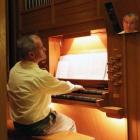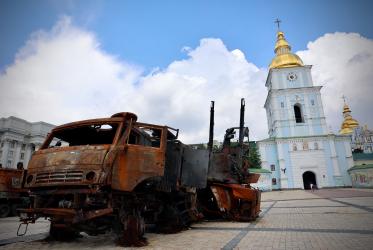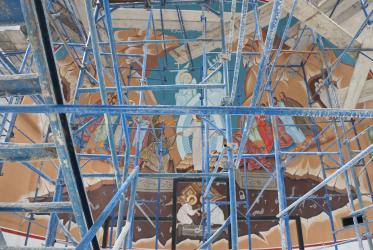Patrick, brought music from Zimbabwe and surroundings into the ecumenical stream. But he was more an incarnation of Zimbabwean music than a provider of resources. With Patrick, we didn't start by reading the notes. We began by listening and learning the part. It was a serious shift for those of us from the West. One's ability to quickly put phrases in the memory was as important as discerning what was on the page. I remember getting desperate to see what those words looked like, because my English-attuned brain was not catching the sounds. I would get annoyed because the demonstrated part would not be quite the same as sung on the previous round. But we learned another way of learning, more flexible than the slavery of notes, more implanted and embodied than skimming from a page. Patrick paid attention to detail, but the more pressing concern was catching the pulse of the song.
My first memory of Patrick was at a music workshop in Canada. In telling us about the change happening in the music of the churches, he mirrored the old Western straightjacket with two lines of Holy, holy, holy, Lord God, almighty. We all laughed. Then he started to play his rattle. Quite amazing what a difference a rattle makes. He told us of the fierce battle that was being waged to get the rattle allowed in worship. Just to make sure we did not become overly romantic about rattles, he noted the ensuing problem: trying to reduce the volume of rattles so they would not overwhelm the singing. His big, hearty smile pulled us along with him, and soon, he had us on our feet trying out how to move.
He was part of the famous team of musical animateurs at the Vancouver Assembly in 1983. Over many worship workshops sponsored by the World Council of Churches, he invited others into the harmonies and rhythms of his continent. Others were more proficient at explaining the theories of cross rhythms and layered beats, but he invited us into the spirit of the songs. He worked really hard at developing an organization of African church musicians on a continental level. This was defeated partly by the sheer difficulty of traveling within Africa, and communicating across borders. Along the way he studied in the US so he would have the credentials to teach music at Africa University, near Mutare, Zimbabwe. He composed songs, like Jesu tawa pano, which has found its way into hymnals all over the world. But more importantly, he sang the songs his churches were singing so we could learn them, too.
He organized and conducted the choir for worship at the Harare Assembly in 1998. It is a credit to his stamina that he served to the end of that incredibly difficult undertaking. He endured uncertain sound equipment, a sickness which circulated through the Assembly, a choir strike (because others were getting paid and they were not,) and patient coaxing of singers to learn something totally strange for them. It is not easy to get a Zimbabwean tenor NOT to harmonize when singing something from the Greek Orthodox tradition. But he also knew how to let them loose, so when they were on home ground, the Assembly could feel the power of his tradition.
My most vivid memory of Patrick comes when he led an Alleluia from Zimbabwe in the Cathedral of Copenhagen, Denmark. The occasion was the World Summit on Sustainable Development in 1995. My colleagues at the Ecumenical Centre in Geneva wanted a service reflecting the world. The Bishop of Copenhagen thought the Danish Lutheran tradition should be on display. Patrick was our point person representing the non-Danish world, and he had one little Alleluia. Although we had pleaded for teaching the song before the service so that those unfamiliar could participate more easily, the Bishop announced that this was not in the Danish tradition. In the service we came to the Alleluia. Patrick led it, and the congregation mumbled along. Then he stopped and remarked that of course in Zimbabwe, they wouldn't sing like that. Then he smiled, eyes opened wide, and did what he so often did. He invited the world, and also some Danes, into the dance.







